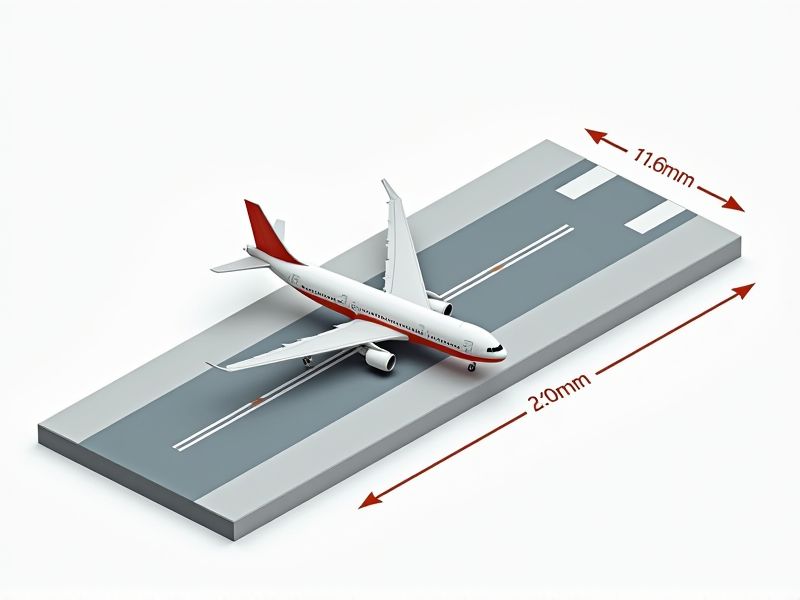
Runway dimensions can vary based on the type of airport and the types of aircraft it serves, but most commercial airports follow standard guidelines for safety and efficiency. According to the International Civil Aviation Organization (ICAO), a typical runway width for major airports handling large jet aircraft is 45 meters (about 150 feet), and the length can range from 2,500 to 4,000 meters (about 8,200 to 13,100 feet), depending on altitude, climate, and aircraft requirements. Smaller regional airports might have runways as narrow as 18-30 meters (60-100 feet) and lengths ranging from 900 to 1,800 meters (3,000 to 6,000 feet). When designing or evaluating a runway, always refer to local regulations and ICAO or FAA standards to ensure the right fit for your operations.
Runway Length
Runway length is a critical factor in aviation, determining the safety and efficiency of takeoffs and landings. For commercial jets, a minimum runway length of 3,600 feet is often required for optimal performance under standard conditions. Shorter runways may limit aircraft weight and necessitate specific operational considerations, including weather and altitude factors. Ensuring your runway meets or exceeds these standards can significantly enhance operational safety and compliance with aviation regulations.
Runway Width
Runway width is a critical aspect of airport design, ensuring safe and efficient aircraft operations. The standard width for runways handling large aircraft typically ranges from 45 to 60 meters, while smaller runways may be constructed with widths of 30 to 45 meters. Airports must comply with regulations set by organizations such as the International Civil Aviation Organization (ICAO) to meet safety standards. Your understanding of runway width is essential when evaluating airport capacity and operational efficiency, as it directly influences takeoff and landing procedures.
Threshold Markings
Threshold markings are essential for runway operations, indicating the beginning of the usable runway length. Typically, these markings are 12 feet in width and extend across the runway's full length, ensuring that pilots can easily identify the landing area. Proper visibility of threshold markings is crucial, particularly during low-light conditions, as airport regulations dictate specific color contrasts, usually white, for improved visibility. Ensuring that your airport's threshold markings are maintained and visible enhances safety during landings and takeoffs, thereby promoting efficient aircraft operations.
Runway Shoulders
Runway shoulders, essential components of airport design, typically extend between 10 to 30 feet from the runway edge, providing critical space for aircraft maneuverability. This area enhances safety by allowing sufficient clearance for wing tips and reducing potential runway incursions. The design standard varies based on aircraft type, with wider shoulders accommodating larger aircraft effectively. Ensuring that your airport complies with the latest Federal Aviation Administration (FAA) guidelines can significantly improve operational efficiency and safety.
Runway End Safety Area
The Runway End Safety Area (RESA) is a crucial safety feature at airports, typically measuring 240 meters in length and 150 feet in width, designed to minimize the risk of accidents during takeoffs and landings. According to international aviation regulations, RESAs provide a buffer that enhances the likelihood of a safe stop for aircraft that overruns the runway. Proper construction and maintenance of RESAs significantly reduce the potential for injury and damage, as they are typically composed of a surface capable of supporting emergency vehicles and mitigating the impact of an aircraft incident. Understanding the critical dimensions and safety implications of RESA can help enhance your knowledge of air transport safety measures.
Taxiway Connections
The standard for runway focus on taxiway connections emphasizes a minimum separation distance of 250 feet to ensure safe aircraft movement. Compliance with these standards enhances operational efficiency, reducing the risk of runway incursions. Most airports implement standardized markings and signage to clearly indicate taxiway routes, facilitating better navigation for pilots. Regular inspections, mandated at least once a month, help maintain these taxiway connections in optimal condition, ensuring safety and reliability in airport operations.
Runway Gradient
Runway gradient, a crucial aspect of runway design, directly impacts aircraft takeoff and landing performance. A standard gradient of 1-2% is typically recommended for optimal drainage and safety. Exceeding this gradient can introduce challenges for pilots, particularly during adverse weather conditions. Understanding the significance of runway gradient helps ensure that your airport operations minimize risks and enhance overall flight safety.
Obstacle Clearance
The standard for runway obstacle clearance mandates that a minimum of 35 feet vertical clearance is maintained above objects within a specified distance, typically 150 feet from the runway centerline. This regulation ensures safety during takeoff and landing phases for aircraft, particularly in environments with varied topography. For standard runway operations, a clear zone of 1,000 feet is generally required beyond the runway's physical length to protect against ground obstructions. Compliance with these guidelines is crucial for enhancing overall flight safety and operational efficiency in aviation.
Runway Strip Width
Runway strip width is a critical aspect of airport design, ensuring the safety and operational efficiency of aircraft during takeoff and landing. According to ICAO guidelines, the recommended runway strip width varies, with a standard width of 150 feet for runways serving aircraft weighing over 12,500 pounds. This width helps accommodate potential overruns and protects obstacles near the runway. Ensuring your runway meets these specifications can significantly reduce the risk of accidents and enhance airport functionality.
Runway Markings
Runway markings are crucial for safe aircraft operations, providing pilots with visual cues for takeoff, landing, and movement. The International Civil Aviation Organization (ICAO) stipulates specific dimensions and colors for runway markings, with a common width of 60 centimeters for the centerline. Runway thresholds, designated by distinct markings, typically measure 45 meters in length, ensuring clear identification of the usable runway area. Proper maintenance of these markings, including repainting and clearing debris, can significantly enhance safety, allowing for optimal aircraft maneuverability and reducing the risk of accidents.
